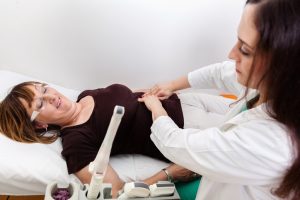 Overactive bladder (OAB) is often associated with menopause, as both conditions are age related. This bladder condition commonly affects women aged 45 to 55 – who are quite likely to be undergoing menopause, too. OAB affects at least 17 percent of menopausal women – although the actual numbers are probably higher. Gauging the exact number of women living with OAB is difficult as many of them are too embarrassed to talk to their doctor about it – although they should, as there are treatments available to help manage this condition.
Overactive bladder (OAB) is often associated with menopause, as both conditions are age related. This bladder condition commonly affects women aged 45 to 55 – who are quite likely to be undergoing menopause, too. OAB affects at least 17 percent of menopausal women – although the actual numbers are probably higher. Gauging the exact number of women living with OAB is difficult as many of them are too embarrassed to talk to their doctor about it – although they should, as there are treatments available to help manage this condition.
So what is the connection between OAB and menopause? Menopause is marked by drastically decreasing levels of estrogen, a crucial hormone for the health of the bladder and urethra tissues. Vaginal dryness and sensitivity during sex are indicators of a potential OAB problem. Similar to the drying and thinning tissues of the vaginal walls, the bladder tissue thins and dries out, too. As a result, your bladder becomes very sensitive even to the smallest triggers, like coughing or laughing.
Bladder problems and menopause
Advertisement
There are three main types of bladder problems that women may experience during menopause:
Urgency: An immediate need to urinate. Holding in is not an option.
Frequency: The need to urinate often (more than eight times a day), which results in sleep disruptions.
Urge incontinence: The need to urinate is incredibly strong and occurs suddenly. The likelihood of an accident is quite high in this condition.
Treatment options for bladder control during menopause
Despite the embarrassment and hesitation you may feel about addressing your OAB with your doctor, a proper consultation from a healthcare professional can offer you viable treatment options to manage your menopause-related bladder problems. Some of those treatment options include:
- Prescription medications
- Vaginal estrogen cream
- Biofeedback therapy
- Electrical stimulation
- Pessary, a fitted ring-shaped device pressing against the urethra to help prevent leaks
- Surgery, to lift the bladder or support the urethra
Your diet is an important aspect in controlling your OAB, too. If you’ve been diagnosed with overactive bladder, you should steer clear of acidic foods like tomatoes and oranges, curb your intake of caffeine and alcohol, stay hydrated, and get enough fiber.
Taking in adequate fiber is important for OAB treatment because without fiber you can develop constipation, which creates a blockage for bladder outflow.
Also, maintaining a healthy weight is recommended for preventing obesity-related OAB symptoms. A balanced diet with essential nutrients is not only crucial for our overall health, but quite beneficial for our bladders as well.
Advertisement
Foods to avoid with an overactive bladder include caffeinated foods and beverages, alcohol, spicy foods, citrus foods and beverages, carbonated foods, milk and milk products, sugar or honey, and artificial sweeteners.
Foods that are good to enjoy with an overactive bladder include non-citrus fruits, grains, legumes, and vegetables.
Here are some tips to keep your bladder healthy:
- Never hold in your urine for too long as it can damage your nerves that send a response to your brain instructing you when to go.
- Stay hydrated so your body can expel toxins and bacteria to avoid any future UTIs.
- Perform Kegel exercises. This involves squeezing and relaxing the pelvic floor muscles to maintain bladder control.
- Quit smoking as it irritates the bladder.
